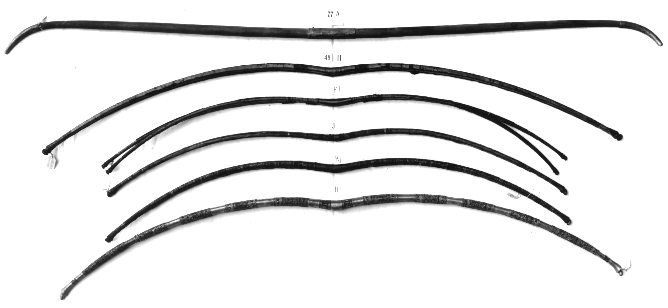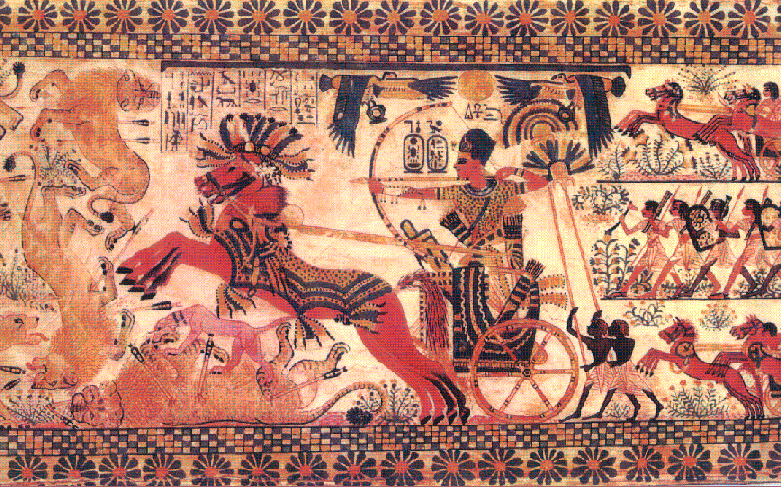Chariot to Heaven
Chapter 3:
A deadly encounter
The chariot was approaching at
breakneck
speed and it seemed that
the young
man
driving it
either liked living dangerously or had some difficulty
controlling his team.
 The
two beautiful
grey horses, as if elated by the expanse of the desert which
suddenly lay
open
before them, needed no
further encouragement
from his whip. Then
another
chariot,
carrying two men, emerged on the desert plateau, and then a
third.
The
two beautiful
grey horses, as if elated by the expanse of the desert which
suddenly lay
open
before them, needed no
further encouragement
from his whip. Then
another
chariot,
carrying two men, emerged on the desert plateau, and then a
third.
 Both
of these chariots
did their best to
stay close to their young leader although
their
drivers
must have found it a very unpleasant
and hazardous task.
Their faces,
their
gloved hands and their clothes were covered with dust
raised by
the wheels of the first
vehicle and the hooves of its horses.
The face
of the poor trumpeter was
purple,
and he
coughed and wheezed
and appeared
to be completely exhausted and not at all well. In
the
confined space
of the desert valley the men in the second and third chariots
could
see
so little of the track that it was left to the horses rather
than
their masters
to decide
which way to go. But now the drivers took advantage
of the
open desert
and the
chariots
fanned out, as if
performing
a
well-rehearsed
manoeuvre. One of them veered to the left
of the desert
track, the
other to the right.
Both
of these chariots
did their best to
stay close to their young leader although
their
drivers
must have found it a very unpleasant
and hazardous task.
Their faces,
their
gloved hands and their clothes were covered with dust
raised by
the wheels of the first
vehicle and the hooves of its horses.
The face
of the poor trumpeter was
purple,
and he
coughed and wheezed
and appeared
to be completely exhausted and not at all well. In
the
confined space
of the desert valley the men in the second and third chariots
could
see
so little of the track that it was left to the horses rather
than
their masters
to decide
which way to go. But now the drivers took advantage
of the
open desert
and the
chariots
fanned out, as if
performing
a
well-rehearsed
manoeuvre. One of them veered to the left
of the desert
track, the
other to the right.
The
leading chariot was
quite
close to the spot where the children
had been having
their
picnic. They stood with their mouth open, as if mesmerised
by the
magnificent sight. It
was Meryt who first realized what was
happening. She
pushed Ipi deeper into the shade
of the dilapidated hut and
whispered in
a strangely squeaky voice "the king! the king!"
Only then it dawned on Ipi that the
young man in
the first
chariot was king
Tutankhamun
going to
hunt gazelle in
the desert
to the west of Mennufer. It was said
that the best gazelle hunting
ground was
at some distance to the north of the city, near
the three
large pyramids
and the huge human-headed lion statue of the
god Haremakhet, but neither
Ipi nor
Meryt had ever been so far away from their homes.
This, however,
was
hardly the
best time to think about gazelle! It was not advisable to gawk
at the Majesty of the King
of Upper and Lower Egypt, who was also a living god, and
so both
children
crouched low
and tried
to be as inconspicuous as possible in their small
stone shelter.
Then
Ipi glanced towards the group of huts at the other side of
the
desert track
and his
mouth fell open once again. The distinguished stranger
whom he
had previously noticed
hiding there was
now transformed
into an archer drawing his bow
ready for
action. His
bow
seemed to be covered
with some
white material
which momentarily
reflected a ray of sun and
it must
have been this which attracted Ipi's
attention. But
Tutankhamun's chariot
was
suddenly almost on top of them,
and then it
all happened at once. There was
an unexpected
high-pitched but soft noise, more like
a
sigh,
followed by
a sharp
crack just above them, and then Ipi felt a twinge of pain in
his forearm.
Several wooden splinters landed around
them. And then Tutankhamun's
chariot
went rushing past,
neither its royal charioteer not his retinue
apparently noticing
anything unusual.
Quite
involuntarily, Ipi got up to his feet and, looking after the
chariot which
was now
disappearing into the distance, tried to
comprehend what
had happened.
Meryt
shouted
something which he could not understand but
it all
became clear when he looked again
across the desert track. The arrow had been aimed directly at
the king, but had struck
the wall just above the children. The
stranger was
gazing
in their direction and
his right
hand was
reaching for another
arrow
in an ornamental leather
case at his feet. It was
Ipi's turn to start yelling
something,
but Meryt understood their danger straight away.
They both took off
as fast
as they could towards the nearest sand dune. They were over
its top
in no
time at all, and ran at full speed in the direction
in which they
believed
was
the building site of General Haremhab's tomb.
The
tall stranger abandoned his weapons, discarded his elegant
cloak, and
chased after them. The surface of the desert was uneven,
pitted with
small craters,
and
it varied between patches which were covered
in stones
and were reasonably
firm
underfoot and others which were sandy and which
made running
very difficult. The tall
would-be assassin was
gaining on them slowly
but
steadily.
On several occasions Meryt
stumbled and Ipi had to
pull her
up to her feet. Then, suddenly, their pursuer was no
longer to be
seen. This
had them worried, although they knew that the General's tomb,
and safety,
could not have been far away. They rounded a small sand dune
which
obstructed
their
view. And that
was when they ran straight into
the arms of a
man
who
appeared
seemingly from nowhere.
The first illustration shows several bows found in the tomb of Tutankhamun:
a self bow (top) and five composite bows. H. Burton photo. 484.
© Griffith Institute, Ashmolean Museum,
Oxford.
The second illustration shows Tutankhamun driving his chariot
during a lion hunt. This is a detail of pl. iv in
Tutankhamun's Painted Box, by Nina
M. Davies and Alan H. Gardiner (Oxford: Griffith Institute,
1962). © Griffith Institute, Ashmolean Museum Oxford.
The box is in Cairo Museum, JE 61467.
Ancient Egypt briefing
The pyramids at Giza
The Sphinx at Giza
The composite bow
On to Chapter 4.
 The
two beautiful
grey horses, as if elated by the expanse of the desert which
suddenly lay
open
before them, needed no
further encouragement
from his whip. Then
another
chariot,
carrying two men, emerged on the desert plateau, and then a
third.
The
two beautiful
grey horses, as if elated by the expanse of the desert which
suddenly lay
open
before them, needed no
further encouragement
from his whip. Then
another
chariot,
carrying two men, emerged on the desert plateau, and then a
third. Both
of these chariots
did their best to
stay close to their young leader although
their
drivers
must have found it a very unpleasant
and hazardous task.
Their faces,
their
gloved hands and their clothes were covered with dust
raised by
the wheels of the first
vehicle and the hooves of its horses.
The face
of the poor trumpeter was
purple,
and he
coughed and wheezed
and appeared
to be completely exhausted and not at all well. In
the
confined space
of the desert valley the men in the second and third chariots
could
see
so little of the track that it was left to the horses rather
than
their masters
to decide
which way to go. But now the drivers took advantage
of the
open desert
and the
chariots
fanned out, as if
performing
a
well-rehearsed
manoeuvre. One of them veered to the left
of the desert
track, the
other to the right.
Both
of these chariots
did their best to
stay close to their young leader although
their
drivers
must have found it a very unpleasant
and hazardous task.
Their faces,
their
gloved hands and their clothes were covered with dust
raised by
the wheels of the first
vehicle and the hooves of its horses.
The face
of the poor trumpeter was
purple,
and he
coughed and wheezed
and appeared
to be completely exhausted and not at all well. In
the
confined space
of the desert valley the men in the second and third chariots
could
see
so little of the track that it was left to the horses rather
than
their masters
to decide
which way to go. But now the drivers took advantage
of the
open desert
and the
chariots
fanned out, as if
performing
a
well-rehearsed
manoeuvre. One of them veered to the left
of the desert
track, the
other to the right.